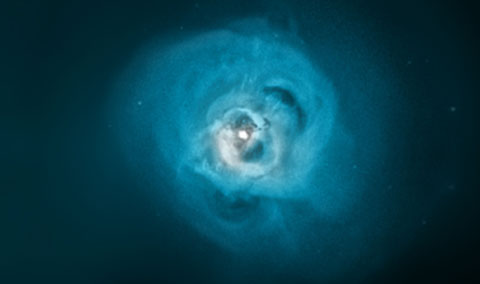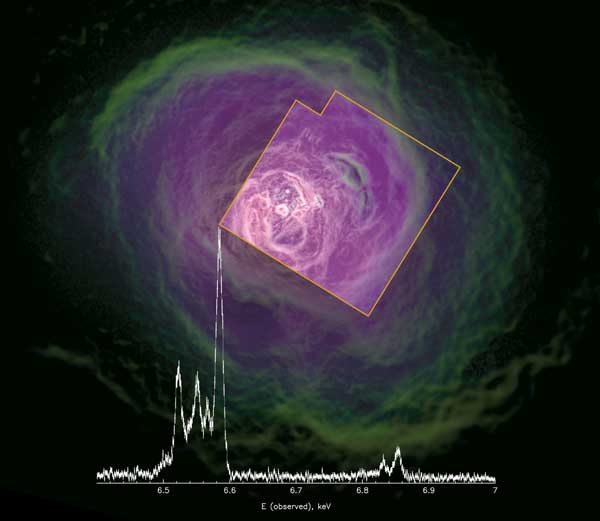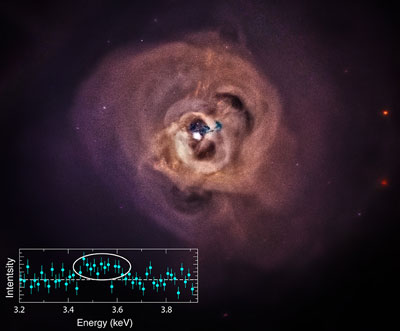In its first — and final — month of flight, the Hitomi X-ray observatory measured the calm within the bubbling core of the Perseus Cluster.

The rocket carrying the Hitomi X-ray observatory launched without a hitch on the morning of February 17th. But just five weeks later, the system that was supposed to keep Hitomi pointed at the stars instead sent the satellite into a tumble. Ultimately, the uncontrolled spin ripped off the satellite’s solar panels, spelling the end of a mission that many had hoped would revolutionize X-ray astronomy.
Hitomi (which means “pupil of the eye” in Japanese) had carried a unique X-ray detector known as a calorimeter. Of all the space-based X-ray observatories flown so far, Hitomi’s calorimeter would have been the first to record the heat generated by each incoming photon (and therefore its energy) with exquisite precision. Earlier attempts to fly similar instruments aboard Astro-E and Suzaku had failed — Astro-E didn’t make it to orbit and Suzaku’s calorimeter lost its helium coolant to a leak before it ever collected data.
The technology had promised to reveal the swirling motions of hot gas near black holes and at the cores of galaxy clusters with unprecedented clarity. So while there were many reasons to get excited about Hitomi, the calorimeter was a biggie.
Fortunately, astronomers got a chance to use it before everything went wrong.
Gazing at Perseus

NASA / CXC / SAO / E. Bulbul & others / XMM / ESA
As Hitomi was testing all its instruments, the calorimeter took a good long look (2.7 days’ worth of exposure time) at the Perseus galaxy cluster. The Hitomi collaboration, including corresponding author Andrew Fabian (Cambridge University, UK), published the results in the July 6th Nature.
Perseus contains more than a thousand galaxies, making it one of the most massive structures in the universe. It’s probably most famous for its “cosmic B-flat note”: the supermassive black hole at the core of the galaxy’s central galaxy powers two plasma jets that send out pressure waves roughly every 10 million years, clearing out gigantic bubbles that cascade outward into the cluster. (Pressure waves are akin to sound waves, and their frequency is akin to a B-flat note 57 octaves below middle C, if you want to call that a note.)

Hitomi Collaboration / JAXA / NASA / ESA / SRON / CSA
Hitomi’s job was to look into this bubbling gas and measure the chaotic, turbulent motions that ought to follow a passing pressure wave. But the team found that the gas was surprisingly quiet. Not only were gas speeds generally low (“only” 150 kilometers per second, or 340,000 mph), but turbulence levels were low, too.
That’s good news for cosmologists, who observe clusters to see how the universe evolves over cosmic time. They like to estimate a cluster’s mass by measuring the brightness of its X-ray-emitting gas, but to do that, they have to assume that turbulence is negligible. The fact that it is (at least in this one part of this one cluster) means cosmologists can rest a little easier.
But low levels of turbulence mean there’s still something missing from our understanding of the inner regions of the Perseus Cluster. The black hole–generated bubbles are supposed to heat gas in the cluster’s core, which sizzles at millions of degrees out to 300,000 light-years or so (well beyond the central galaxy). The gas is too calm for turbulence to be responsible, so something else must be carrying the energy outward into the cluster.
More to Come from Hitomi

NASA / CXC / SAO / E. Bulbul & others
The Perseus observations, early as they were, came when the spacecraft was still letting off (helium) steam. As a result, Hitomi didn’t measure the full range of energy it was capable of gathering — energies below 3 keV were blocked to minimize contamination. But the spectrum published in Nature only spans from 5.5 keV to 8.5 keV. Fabian says that the team is working on the lower-energy data now.
Especially of interest is the part of the spectrum where the X-ray photons have about 3.5 keV. That’s where a research group recently found a mysterious spectral emission line that might come from dark matter. We can expect to hear more from Hitomi and its study of the Perseus Cluster shortly, Fabian says.
 1
1









Comments
Anthony Barreiro
July 7, 2016 at 1:54 pm
57 octaves below middle C is truly basso profundo!
And it seems like every inexplicable observation is taken as possible evidence of dark matter. Sooner or later somebody's going to be right.
You must be logged in to post a comment.
You must be logged in to post a comment.